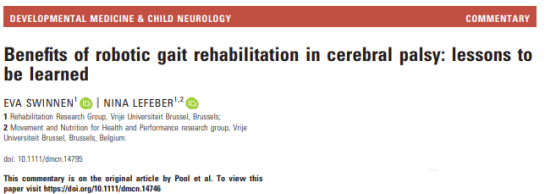
Commentary about the benefits of robotic gait rehabilitation in cerebral palsy by Eva Swinnen and Nina Lefeber.
Benefits of robotic gait rehabilitation in cerebral palsy: lessons to be learned
Eva Swinnen and Nina Lefeber (RERE, VUB)
There is now evidence that gait rehabilitation robots have beneficial effects for the rehabilitation of children with cerebral palsy (CP), but there are still many questions remaining. Such as, which type of robotic device should be used? What kind of children would benefit the most? What is the optimal training dose?
In general, two types of gait rehabilitation robots can be distinguished: end-effectors and exoskeletons. End-effectors are stationary devices that use footplates to guide the feet and reproduce gait trajectories. Mechanical forces are applied to the distal segments of the lower limbs, imitating to a certain degree the stance and swinging phases of the gait. Exoskeletons are devices that operate mechanically and simultaneously on the human body. They generally use a set of cuffs connected to the patient’s lower limbs. There are wearable exoskeletons for both overground walking and for walking on a treadmill. A key difference between end-effectors and exoskeletons is located at the level of the legs: while end-effectors only act on the feet, lower limb exoskeletons act on the hip, knee, and sometimes the ankle joints.
The full commentary can be found here.
